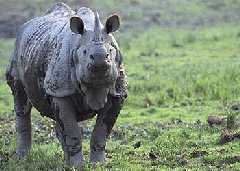Archives
White Paper on One Horn Rhino
The organization, in a statement issued from Houston insisted that ‘since the Assam government had failed miserably in its duties, the administration of Kaziranga should immediately be placed under military rule for the time being with strict orders to treat the poachers as terrorists’. A citizen’s vigilance committee was also advocated by them to monitor the situation on a regular basis in the national parks of the state. It may be mentioned here that the state government, following the growing public outrage, had asked for a Central Bureau of Investigation probe into the killing of over 30 rhinos in different preserves of Assam since January 2007. The chief minister Tarun Gogoi on May chief minister Tarun Gogoi on May 2 declared that his government favoured a CBI enquiry into the matter.
 Earlier the civil societies and the advocacy groups of the region rigorously raised their voices against the slaughtering of rhinos by poachers since the early part of 2008. But the concerned authority and the state government preferred to overlook the public resentment. For more than three months, the wildlife lovers have strongly condemned the authority of Kaziranga, which had witnessed the loss of 26 rhinos to poachers since January 2007.
Earlier the civil societies and the advocacy groups of the region rigorously raised their voices against the slaughtering of rhinos by poachers since the early part of 2008. But the concerned authority and the state government preferred to overlook the public resentment. For more than three months, the wildlife lovers have strongly condemned the authority of Kaziranga, which had witnessed the loss of 26 rhinos to poachers since January 2007.
Recognized as a safe heaven for the rhinos, Kaziranga gives shelter to almost two-thirds of the total population of one-horned rhinos on Earth. A 1984 census showed that Kaziranga, which was declared a National Park in 1974, had 1,080 rhinos. This number increased during 1975 to 1990, nearly 25 per year. The statistics showed that rhino population was found to be at 1069 in another census during 1991. The census in 1999 provided more optimistic results as the number of rhinos soared to 1,552. The last census in 2006 revealed the number of rhinos in the park at 1,855.
The rhino horn enjoys great demand in international market as it is considered to contain aphrodisiac qualities. Many people consider the rhino horns as another kind of traditional viagra. The horns are also believed to have medicinal values. Traditional Chinese medicine demands rhino horns, which are believed to be a quick cure for fever and stomach ailments. China, Taiwan, Thailand, South Korea and the Middle East are known to be huge markets for illegal trading of rhino horns. Rhino horns fetch a few thousand US dollars per kilogram in the international market.
The public resentment against the government for its failure to protect the rhinos was led by the All Assam Students Union (AASU), which recently carried out demonstrations throughout Assam. The AASU activists also organized a citizens’ meet at Kohora in Kaziranga locality to continue hammering on the authority. The daylong meet which was attended by various pressure groups, resolved to emphasize on a CBI probe to catch the real perpetrators behind rhino poaching.
The concern for the rhinos remained visible in Assam media through their editorials and the letters to the editor columns. Concerned ordinary citizens and the opposition political parties, journalists bodies also expressed their deep anguish against the continued poaching of rhinos in Assam, particularly in Kaziranga.
Earlier, the Nature’s Beckon, an active environment NGO of the region, staged a protest rally against the forest department of Assam. The director of Nature’s Beckon, Soumyadeep Datta came out with the shocking revelation that the forest department of Assam was itself involved in the illegal trade of rhino horns.
“We have authentic information that the forest department sold more than 300 rhino horns even after India adopted the wildlife protection act in 1972. And we are ready to provide all relevant information to CBI once it starts investigating. The statistics of the sold rhino horns can be placed year by year as 29 (during 1971-72), 13 (1972-73), 19 (1973-74), 40 (1974-75), 18 (1975-76), 27 (1976-78), 42 (1977-78), 63 (1978-79), 63 (1978-79), 61 (1979-80),” Datta claimed.
In India, poaching is a punishable offence with up to seven years’ imprisonment. India has been a member to the Convention on International Trade in Endangered Species since 1976 and hence, in principle at least, is bound by all its efforts to eliminate International trade in wildlife and wildlife parts, he added.

